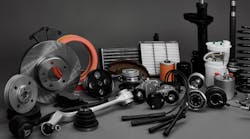Is There Value in Identifying Criticality of Spare Parts?
For more than a decade we have been coaching our clients to identify their critical spares at the earliest possible opportunity – ideally when an item is first ordered and/or set up in the system – and review them on a periodic basis to keep the information up to date.
Unfortunately, that advice often comes too late or goes unheeded, and they find themselves in a position where they need to review thousands and thousands of parts to catch up or keep up.
When these situations arise, the first obstacle is usually finding the time, energy, information, and resources required to start grinding through the process. The next challenge is to define exactly what makes a particular part critical. Or, more importantly, what I am going to do with the evaluation results?
Describing what makes something critical is usually pretty simple. There is general agreement that if the lack of a particular part could cause significant downtime or impact to production, the environment, or safety, then that item is most likely critical. Translating these general guidelines into something more specific at the part level is another story.
To make the criticality assessment less subjective, people (ourselves included) have come up with all kinds of evaluation tools. You’ve probably seen one: half a dozen or more criteria with different rating scales levels based on a number of variables. You score each of the attributes, add them up, and compare the total to a threshold that determines whether the part is critical or not. While never a perfect solution, this more objective approach provides a method for the evaluation which can be improved over time.
But is it as simple as saying a particular part is critical or not critical? That would imply that the decision process has purely binary logic paths. Before you go down that road, you first need to think about WHY you want to evaluate the criticality of your spares in the first place. For example, do you want to:
- Prioritize which motors you have on shaft rotation PM while in stock? Certainly there is a difference between the single 500-HP AC Motor in stock vs. the 50 5-HP AC Motors stocked.
- Know how to justify why some stocked spares have had no movement in over five years? Not all stocked items are intended for movement due to irregular demand. Some items are purely “insurance spares” that you hope to never need to use, but could have a dramatic impact if not available when needed.
- Prioritize how/when you evaluate your stocking strategy (min/max, order quantities, etc.), other than being triggered by stock-outs?
For any of these scenarios, you would likely have three to five strategic approaches and you would want your evaluation results to support these. Notice something missing above? No mention of stock or non-stock. That is the second step which we get to later because, although a spare may be rated as critical, that does not necessarily mean that it should be stocked.
So back to the objective scoring method. One challenge with this method is that people think because math is involved then somehow the evaluation is more accurate than just someone’s gut instincts. The rating scale may say that a six-week lead time is worth 10 points while a four-week lead time is worth five; but who says having a six-week lead time is twice as bad as a four-week lead time? That is why you are not solely limited to just one factor for the evaluation.
Another challenge is that you may constrain yourself to an arbitrary critical/noncritical cutoff. Suppose the cutoff is set at 100 points. Who says if you rack up exactly 100 points that means the part is critical but if it only scores 99 it isn’t? Is the model that precise? The only way to find out is to run all of your parts through the exact same analysis and then determine where the cutoff is between critical and non-critical. And in most cases, even this is based on someone’s judgment. This is all the more reason to have multiple criticality levels rationalized that have progressive strategies associated with them.
What often happens is that people go through the analysis for a particular part and then at the end ask themselves if they feel comfortable with the answer (“Hmmm, seems like 90 is a little low for this one, I would have expected it to be higher.”). If they don’t trust the result, then they just go back and tweak one or two of the attributes so it comes out the way they thought it should have in the first place. If you find yourself doing this, then your criticality tool probably isn’t valid unless you apply the change to the evaluation criteria across the board (i.e. improve the system).
Depending on where you look, there are also benchmarks suggesting that no more than 2% to 5% of your total spares should be critical. Just knowing that target can influence people to change their opinion one way or another depending on how many they have already identified.
So how DO you decide whether a particular part is truly critical? The good news is you may not have to worry about it. Before you embark on a labor-intensive criticality evaluation, you have to remind yourself what you will do with the information once you have it.
For example, if you determine that a part is critical, does that mean it should be on a bill of material (BOM)? One could argue that this is backward thinking, i.e. you should build your BOMs first and then determine which of those items on the BOM are critical.
Does a critical spare have to be in inventory? Certainly the more critical a part is, the more important it is to have one readily available when needed, and in most cases this means having it in stock. But what if you can make a deal with a local supplier to hold one for you? What if it takes two hours before you are ready to replace the part and you can get one in an hour? A key element of fundamental inventory management is making sound stocking decisions for every part – critical or not – based on estimated demand, lead time, criticality of the asset the part is used on, and how quickly you need one. In general, the criticality of a part itself does not dictate the stocking plan.
If you determine that a part is critical, does that mean you are going to establish inspections and/or PMs in the warehouse to ensure the integrity of the part while it sits in inventory? That would seem to make sense, but these activities shouldn’t necessarily be limited to only the most critical parts. For instance, any expensive motor, pump, or gearbox – critical or not – should be considered a likely candidate for some warehouse maintenance activities to keep them in good working condition on the shelf. So maybe you should include the unit cost of the item as a criticality factor – another improvement that can be made to the system.
Keep the End in Mind
Will the criticality impact the ABC code for the part? ABC classifications do provide a relative priority for purposes of inventory management (e.g. location, cycle counting, etc.), but that priority is generally based on activity level or turnover rather than criticality.
Having an idea of the end in mind (the process(es) for how the results will be strategically used to benefit the business) is key to making the evaluation a worthwhile activity. If nothing else, simply getting together to do the evaluations can sometimes generate productive discussions among key stakeholders about the issues described above.
Regardless of what method you use to determine the criticality of the items, if all you end up with is a piece of parametric data that doesn’t tell you anything else about that part, then why put yourself through all the effort? When you consider how long it will take, you may find that the time would be better spent addressing more important issues like making sure all of your parts are tied to assets through a bill of material; reviewing stocking levels; or other inventory management activities that people never seem to have the time to do.
The bottom line is that if you are going to do a criticality evaluation of your spare parts, make the effort worthwhile by developing your processes first so you know how the results will be used.
Doug Wallace, CPIM, is a Senior Materials Management Subject Matter Expert for Life Cycle Engineering (LCE). He can be reached at [email protected]. Rich Jansen is a Principal Reliability Engineering Subject Matter Expert for LCE and can be reached at [email protected].




